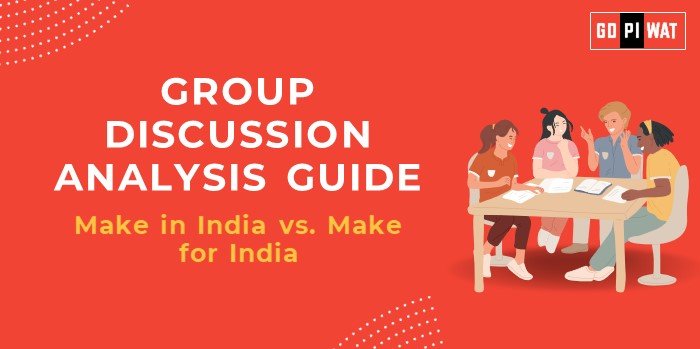📋 Group Discussion Analysis Guide: Make in India vs. Make for India
🌐 Introduction to Make in India vs. Make for India
The debate between “Make in India” and “Make for India” reflects two strategic directions for economic growth in India. “Make in India” aims to boost manufacturing and attract foreign direct investment (FDI) by encouraging production within India for both local consumption and export. Meanwhile, “Make for India” emphasizes producing goods and services tailored to Indian consumers’ unique needs, supporting inclusive growth by focusing on domestic demands.
📜 Background
Launched in 2014, “Make in India” was designed to transform India into a global manufacturing hub. However, the focus on exports has spurred discussions on balancing with “Make for India”—producing for the Indian consumer to address pressing domestic needs. The intersection of these approaches highlights economic policy, consumer trends, and India’s goals for self-sufficiency.
📊 Quick Facts and Key Statistics
- 🏭 Manufacturing Sector’s Contribution to GDP: The manufacturing sector contributed approximately 17.3% to India’s GDP in 2023-24, down from a peak of 18.5% in 2021-22. This drop underscores the challenges “Make in India” faces in reaching its goal of a 25% GDP share.
- 💰 Foreign Direct Investment (FDI): FDI in India’s manufacturing sector rose by 69% over the past decade, reaching USD 165.1 billion from 2014-2024. This rise demonstrates strong global confidence in India’s manufacturing capabilities, furthering the aims of “Make in India”.
- 📱 Mobile Phone Manufacturing: India’s mobile phone exports surged from ₹1,566 crore in 2014 to over ₹1.2 lakh crore in 2024, with imports decreasing by nearly 85%. This transition from importer to exporter showcases a sectoral success under “Make in India”.
- 🎯 Production Linked Incentive (PLI) Scheme: With an outlay of ₹1.97 lakh crore, the PLI scheme has bolstered sectors like electronics and pharmaceuticals, enhancing India’s export competitiveness and job creation. As of 2024, PLI approvals led to investments of ₹1.23 lakh crore, generating around 800,000 jobs.
- 👷 Employment Growth in Manufacturing: Employment in manufacturing increased from 57 million in 2017-18 to 64.4 million in 2022-23, underscoring the sector’s potential for job creation through policies supporting both domestic and export-focused production.
🤝 Stakeholders and Their Roles
- Government: Leads policy-making, infrastructure development, and FDI promotion.
- Indian Corporates: Companies like Reliance and Tata play roles in both domestic and export markets.
- Global Firms: Multinationals like Apple and Samsung benefit from manufacturing incentives.
- Consumers: Their demands drive the shift toward Make for India, favoring accessible, affordable products.
🏆 Achievements and Challenges
✨ Achievements:
- 💼 Increased FDI: Significant inflows in sectors like electronics, automotive, and defense.
- 📈 Improved Ease of Doing Business: India rose from 142nd in 2014 to 63rd in the World Bank’s ranking.
- 👷 Job Creation: Expanding employment in manufacturing and related sectors.
⚠️ Challenges:
- 📊 Domestic vs. Export Demand: Limited alignment between export-driven production and domestic needs.
- 🔗 Supply Chain Dependencies: Continued reliance on imported components, especially in electronics.
- 🌍 Global Comparison: While China has successfully balanced domestic and export production, India faces steep competition to achieve similar dual success.
Case Study: The electronics manufacturing sector, exemplified by Samsung, showcases both achievements and dependency challenges in balancing domestic production and exports.
🗣️ Structured Arguments for Discussion
- 💬 Supporting Stance: “Make in India has drawn substantial FDI, driving growth in manufacturing and employment.”
- 🤔 Opposing Stance: “While effective for exports, Make in India overlooks domestic needs that a Make for India approach could better address.”
- ⚖️ Balanced Perspective: “Integrating Make in India and Make for India can enhance India’s economic sustainability, meeting both export and domestic needs.”
📝 Effective Discussion Approaches
- Opening Approaches:
- 📊 Data-Driven Start: “India’s manufacturing sector’s 17.3% contribution to GDP reveals room for growth, both domestically and globally.”
- 🔍 Case Contrast: “China’s model of balancing domestic and export production provides valuable lessons for India’s dual strategy.”
- Counter-Argument Handling: Point out hybrid models that cater to both export demand and domestic needs for a more resilient economy.
📊 Strategic Analysis of Strengths and Weaknesses
Strengths: Rising FDI, job creation, established infrastructure in key manufacturing hubs.
Weaknesses: Dependence on imports for components, limited alignment with domestic needs.
Opportunities: Expanding consumer base, technological growth, global shifts in supply chains favoring India.
Threats: Competition from established hubs like China, fluctuating global demand.
🎓 Connecting with B-School Applications
- Real-World Applications: Case projects in supply chain development, consumer analysis, and global marketing strategies.
- Sample Interview Questions:
- “Should India prioritize exports or domestic production?”
- “How does Make for India align with sustainable growth?”
- Insights for B-School Students: Focus on understanding the manufacturing value chain, policy impacts on business, and India’s shifting consumer demands.


